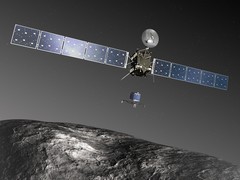500 million miles away, as it hurtles through space in the darkest reaches of our Solar System, an alarm clock goes off. It wakes a small spacecraft from it's two and a half year slumber.
This little spacecraft is called Rosetta. After travelling through space for almost 10 years and covering over 800 million kilometres, Rosetta awoke on Monday of this week, ready to restart its mission to the comet 67P/Churyumov-Gerasimenko.
Rosetta is powered by the Sun's rays, known as solar energy, so the farther the spacecraft travels from the Sun, the less energy it receives. Thirty one months ago, Rosetta was travelling far out in the Solar System, near to the planet Jupiter, and had to be put to sleep to save power.
After spending a decade soaring through the Solar System, flying past Mars and Earth several times and even visiting a couple of asteroids, Rosetta will at last enter the final stretch of its mission later this year.
In August, Rosetta will reach the comet and begin to orbit. For two months the spacecraft will make a detailed map of the comet's surface, looking for a landing site for a probe it is carrying, called Philae (FEE-lay). The landing is planned for 11 November and it will be the first time that a landing on a comet has ever been attempted!
If this high-risk mission is successful, it will provide a large reward. Comets are like time capsules, relics from when our Solar System had just been formed. Studying them helps us understand how our home in the Universe first came into existence.
Cool Fact
Because of Rosetta’s distance from Earth, it takes up to 50 minutes for its messages to reach us!
Share:














